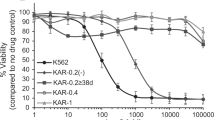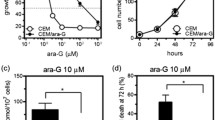Abstract
Purpose
Troxacitabine (BCH-4556, l-(−)-OddC, Troxatyl) is a novel β-l-nucleoside analogue with potent antineoplastic activity both in vitro and in several tumor models in vivo, and is presently in phase II clinical trials. The combination of the cytosine analogues troxacitabine and araC (1-β-d-arabinofuranosylcytosine, cytarabine) has shown promising activity in patients with acute myelogenous leukemia. To further examine the interactions between these two analogues, we investigated the in vitro and in vivo effects of their combination against a human leukemia cell line, CCRF-CEM.
Methods
The in vitro cytotoxic effect of the combination of troxacitabine and araC on the survival of CCRF-CEM cells was measured using a standard MTT assay and combination indices were generated with the CalcuSyn software. For in vivo studies, we evaluated the effect of both drugs, alone and in combination, on survival of CCRF-CEM tumor-bearing animals. Mechanistic studies addressed recovery of DNA synthesis, intracellular levels of araC metabolites, feedback inhibition by triphosphate species and pharmacokinetics of both drugs.
Results
The combination of troxacitabine and araC in vitro was synergistic with combination indices between 0.1 and 0.7. This appeared to be related to the impact of the combination on DNA synthesis recovery, which was significantly delayed following exposure to the combination of troxacitabine and araC compared to either agent alone. Analysis of the effect of troxacitabine on the intracellular metabolites of araC revealed that troxacitabine did not inhibit araC deamination and caused a slight decrease in the overall intracellular accumulation of araCTP. The lower accumulation of araCTP could not be attributed to feedback inhibition caused by troxacitabine triphosphate on dCK. Furthermore, our in vivo experiments demonstrated that the combination of araC and troxacitabine was better at slowing down the progression of leukemia in SCID mice than either agent used alone without additive toxicities. Injections of 10 mg/kg troxacitabine i.p. daily for 5 days in combination with araC at 10 mg/kg led to an increase in median survival time of 58 days compared to 49.5 and 53.5 days for araC and troxacitabine, respectively, given as single agents. This represents an increase in life span of 17%, respectively when compared to araC alone. A pharmacokinetic study revealed that troxacitabine did not influence the disposition of araC when coadministered.
Conclusions
Overall, our results show that the antileukemic activity of troxacitabine and araC is complementary when the two nucleoside analogues are combined in vivo. These effects appear to be related to their interaction at the level of DNA repair rather than to pharmacokinetic interactions. These results encourage the use of troxacitabine and araC in combination in patients with acute leukemia.




Similar content being viewed by others
Abbreviations
- AML:
-
Acute myelogenous leukemia
- araC:
-
1-β-d-Arabinofuranosylcytosine, cytarabine
- araCMP:
-
Cytarabine-5′-monophosphate
- araCTP:
-
Cytarabine-5′-triphosphate
- araU:
-
1-β-d-Arabinofuranosyluracil
- dCyd:
-
Deoxycytidine
- CDA:
-
Cytidine deaminase
- CI:
-
Combination index
- dCK:
-
Deoxycytidine kinase
- dCTP:
-
Deoxycytidine-5′-triphosphate
- dFdC:
-
Gemcitabine, 2′,2′-difluorodeoxycytidine
- troxacitabineTP:
-
Troxacitabine 5′-triphosphate
References
Bélanger K, Moore M, Baker SD, Dionne J, Maclean M, Jolivet J, Siu L, Soulières D, Wainman N, Seymour L (2002) Phase I and pharmacokinetic study of novel L-nucleoside analog troxacitabine given as a 30-minute infusion every 21 days. J Clin Oncol 20:2567–2574
Capizzi RL, Yang JL, Cheng E, Bjornsson T, Sahasrabudhe D, Tan RS, Cheng YC (1983) Alteration of the pharmacokinetics of high-dose ara-C by its metabolite, high ara-U in patients with acute leukemia. J Clin Oncol 1:763–771
Chou KM, Kukhanova M, Cheng YC (2000) A novel action of human apurinic/apyrimidinic endonuclease: excision of L-configuration deoxyribonucleoside analogs from the 3′ termini of DNA. J Biol Chem 275:31009–31015
Chou TC, Talalay P (1984) Quantitative analysis of dose-effect relationships: the combined effects of multiple drugs or enzyme inhibitors. Adv Enzyme Regul 22:27–55
Chow KU, Ries J, Weidmann E, Pourebrahim F, Napieralski S, Stieler M, Boehrer S, Rummel MJ, Stein J, Hoelzer D, Mitrou PS (2000) Induction of apoptosis using 2′,2′-difluorodeoxycytidine (gemcitabine) in combination with antimetabolites or anthracyclines on malignant lymphatic and myeloid cells. Antagonism or synergism depends on incubation schedule and origin of neoplastic cells. Ann Hematol 79:485–492
Cohen A, Barankiewicz J, Lederman HM, Gelfand EW (1983) Purine and pyrimidine metabolism in human T lymphocytes. Regulation of deoxyribonucleotide metabolism. J Biol Chem 258:12334–12340
Datta NS, Shewach DS, Mitchell BS, Fox IH (1989) Kinetic properties and inhibition of human T lymphoblast deoxycytidine kinase. J Biol Chem 264:9359–9364
de Bono JS, Stephenson J Jr, Baker SD, Hidalgo M, Patnaik A, Hammond LA, Weiss G, Goetz A, Siu L, Simmons C, Jolivet J, Rowinsky EK (2002) Troxacitabine, an L-stereoisomeric nucleoside analog, on a five-times-daily schedule: a phase I and pharmacokinetic study in patients with advanced solid malignancies. J Clin Oncol 20:96–109
DeAngelis LM, Kreis W, Chan K, Dantis E, Akerman S (1992) Pharmacokinetics of ara-C and ara-U in plasma and CSF after high-dose administration of cytosine arabinoside. Cancer Chemother Pharmacol 29:173–177
Eliopoulos N, Cournoyer D, Momparler RL (1998) Drug resistance to 5-aza-deoxycytidine, 2′,2′-difluorodeoxycytidine, and cytosine arabinoside conferred by retroviral-mediated transfer of human cytidine deaminase cDNA into murine cells. Cancer Chemother Pharmacol 42:373–378
Frewin RJ, Johnson SA (2001) The role of purine analogue combinations in the management of acute leukemias. Hematol Oncol 19:151–157
Galmarini CM, Mackey JR, Dumontet C (2001) Nucleoside analogues: mechanisms of drug resistance and reversal strategies. Leukemia 15:875–890
Gandhi V, Estey E, Keating MJ, Plunkett W (1993) Fludarabine potentiates metabolism of cytarabine in patients with acute myelogenous leukemia during therapy. J Clin Oncol 11:116–124
Gandhi V, Estey E, Keating MJ, Chucrallah A, Plunkett W (1996) Chlorodeoxyadenosine and arabinosylcytosine in patients with acute myelogenous leukemia: pharmacokinetic, pharmacodynamic, and molecular interactions. Blood 87:256–264
Gati WP, Paterson AR, Belch AR, Chlumecky V, Larratt LM, Mant MJ, Turner AR (1998) Es nucleoside transporter content of acute leukemia cells: role in cell sensitivity to cytarabine (araC). Leuk Lymphoma 32:45–54
Giles FJ (2002) Novel agents for the therapy of acute leukemia. Curr Opin Oncol 14:3–9
Giles FJ, Cortes JE, Baker SD, Thomas DA, O'Brien S, Smith TL, Beran M, Bivins C, Jolivet J, Kantarjian HM (2001) Troxacitabine, a novel dioxolane nucleoside analog, has activity in patients with advanced leukemia. J Clin Oncol 19:762–771
Giles FJ, Faderl S, Thomas DA, Cortes J, Jeha S, Garcia-Manero G, Douer D, Levine AM, Estey EH, Beran M, O'Brien S, Koller C, Andreeff M, Kantarjian H (2001) Troxatyltm plus topotecan, ara-C, or idarubicin in patients (pts) with refractory acute myeloid leukemia (AML), myelodysplastic syndrome (MDS), or blastic-phase chronic myeloid leukemia (CML-BP): a randomised phase I/II study. Blood 98:594a
Giles FJ, Garcia-Manero G, Cortes JE, Baker SD, Miller CB, O'Brien SM, Thomas DA, Andreeff M, Bivins C, Jolivet J, Kantarjian HM (2002) Phase II study of troxacitabine, a novel dioxolane nucleoside analog, in patients with refractory leukemia. J Clin Oncol 20:656–664
Giles FJ, Faderl S, Thomas DA, Cortes JE, Garcia-Manero G, Douer D, Levine AM, Koller CA, Jeha SS, O'Brien SM, Estey EH, Kantarjian HM (2003) Randomized phase I/II study of troxacitabine combined with cytarabine: idarubicin, or topotecan in patients with refractory myeloid leukemias. J Clin Oncol 21:1050–1056
Gourdeau H, Bibeau L, Ouellet F, Custeau D, Bernier L, Bowlin T (2001) Comparative study of a novel nucleoside analogue (Troxatyl, troxacitabine, BCH-4556) and araC against leukemic human tumor xenografts expressing high or low cytidine deaminase activity. Cancer Chemother Pharmacol 47:236–240
Gourdeau H, Clarke ML, Ouellet F, Mowles D, Selner M, Richard A, Lee N, Mackey JR, Young JD, Jolivet J, Lafreniere RG, Cass CE (2001) Mechanisms of uptake and resistance to troxacitabine, a novel deoxycytidine nucleoside analogue, in human leukemic and solid tumor cell lines. Cancer Res 61:7217–7224
Grant S (1998) Ara-C: cellular and molecular pharmacology. Adv Cancer Res 72:197–233
Grove KL, Cheng YC (1996) Uptake and metabolism of the new anticancer compound beta-L-(−)-dioxolane-cytidine in human prostate carcinoma DU-145 cells. Cancer Res 56:4187–4191
Grove KL, Guo X, Liu SH, Gao Z, Chu CK, Cheng YC (1995) Anticancer activity of beta-L-dioxolane-cytidine, a novel nucleoside analogue with the unnatural L configuration. Cancer Res 55:3008–3011
Johnson SA (2001) Nucleoside analogues in the treatment of haematological malignancies. Expert Opin Pharmacother 2:929–943
Kadhim SA, Bowlin TL, Waud WR, Angers EG, Bibeau L, DeMuys JM, Bednarski K, Cimpoia A, Attardo G (1997) Potent antitumor activity of a novel nucleoside analogue, BCH-4556 (beta-L-dioxolane-cytidine), in human renal cell carcinoma xenograft tumor models. Cancer Res 57:4803–4810
Kim MY, Ives DH (1989) Human deoxycytidine kinase: kinetic mechanism and end product regulation. Biochemistry 28:9043–9047
Kukhanova M, Liu SH, Mozzherin D, Lin TS, Chu CK, Cheng YC (1995) L-and D-enantiomers of 2′,3′-dideoxycytidine 5′-triphosphate analogs as substrates for human DNA polymerases. Implications for the mechanism of toxicity. J Biol Chem 270:23055–23059
Lech-Maranda E, Korycka A, Robak T (2000) The interaction of gemcitabine and cytarabine on murine leukemias L1210 or P388 and on human normal and leukemic cell growth in vitro. Haematologica 85:588–594
Mansour TS, Jin H, Wang W, Dixit DM, Evans CA, Tse HLA, Belleau B, Gillard JW, Hooker E, Ashman C, Cammack N, Salomon H, Belmonte AR, Wainberg MA (1995) Structure-activity relationship among a new class of antiviral and heterosubstituted 2′,3′-dideoxynucleoside analogues. Nucleosides Nucleotides 14:627–635
Ohno Y, Spriggs D, Matsukage A, Ohno T, Kufe D (1988) Effects of 1-β-D-arabinofuranosylcytosine incorporation on elongation of specific DNA sequences by DNA polymerase β. Cancer Res 48:1494–1498
Pelicano H, Kukhanova M, Cheng Y (2000) Excision of beta-D- and beta-L-nucleotide analogs from DNA by the human cytosolic 3′-to-5′ exonuclease. Mol Pharmacol 57:1051–1055
Perrino FW, Miller H, Ealy KA (1994) Identification of a 3′→5′-exonuclease that removes cytosine arabinoside monophosphate from 3′ termini of DNA. J Biol Chem 269:16357–16363
Peters GJ, van der Wilt CL, van Moorsel CJ, Kroep JR, Bergman AM, Ackland SP (2000) Basis for effective combination cancer chemotherapy with antimetabolites. Pharmacol Ther 87:227–253
Plowman J, Dykes D, Hollingshead M, Simpson-Herren L, Alley MC (1997) Human tumor xenograft models in NCI drug development. In: Teicher BA (ed) Anticancer drug development guide: preclinical screening, clinical trials, and approval. Humana Press, Totowa, pp 101–125
Plunkett W, Huang P, Gandhi V (1995) Preclinical characteristics of gemcitabine. Anticancer Drugs 6:7–13
Pommier Y, Pochat L, Marie JP, Zittoun RA (1983) High-dose cytarabine in acute leukemia: toxicity and pharmacokinetics. Cancer Treat Rep 67:371–373
Rabbani SA, Harakidas P, Bowlin T, Attardo G (1998) Effect of nucleoside analogue BCH-4556 on prostate cancer growth and metastases in vitro and in vivo. Cancer Res 58:3461–3465
Santini V, Bernabei A, Gozzini A, Scappini B, Zoccolante A, D'Ippolito G, Figuccia M, Ferrini PR (1997) Apoptotic and antiproliferative effects of gemcitabine and gemcitabine plus Ara-C on blast cells from patients with blast crisis chronic myeloproliferative disorders. Haematologica 82:11–15
Tallman MS (2001) Therapy of acute myeloid leukemia. Cancer Control 8:62–78
Tosi P, Pellacani A, Zinzani PL, Magagnoli M, Visani G, Tura S (1999) In vitro study of the combination gemcitabine + fludarabine on freshly isolated chronic lymphocytic leukemia cells. Haematologica 84:794–798
Weitman S, Marty J, Jolivet J, Locas C, Von Hoff DD (2000) The new dioxolane, (−)-2′-deoxy-3′-oxacytidine (BCH-4556, troxacitabine), has activity against pancreatic human tumor xenografts. Clin Cancer Res 6:1574–1578
Acknowledgements
The authors would like to thank Lucie Bibeau, Chantal Boudreau, Dominique Custeau and Marie-Josée Gilbert for their help with the animal studies. Also, we would like to thank Karen Meerovitch for helpful discussions and revision, and Johanne Cadieux for assistance in the preparation of the manuscript.
Author information
Authors and Affiliations
Corresponding author
Rights and permissions
About this article
Cite this article
Bouffard, D.Y., Jolivet, J., Leblond, L. et al. Complementary antineoplastic activity of the cytosine nucleoside analogues troxacitabine (Troxatyl) and cytarabine in human leukemia cells. Cancer Chemother Pharmacol 52, 497–506 (2003). https://doi.org/10.1007/s00280-003-0699-4
Received:
Accepted:
Published:
Issue Date:
DOI: https://doi.org/10.1007/s00280-003-0699-4




